Twins! A Patient Story

Around Christmas 2018, double blessings arrived for the Anderson family of Baltimore County. Identical twin girls, named Amara and Amaris, were born at University of Maryland St. Joseph Medical Center (UM SJMC).
Their names mean "beloved gift of God." And according to their mother, Francine Anderson, her entire pregnancy, delivery at UM SJMC and post-delivery care of the babies have been a series of blessings.
Six weeks into her pregnancy, Anderson discovered she was having twins when "we saw two heartbeats on the ultrasound," she says. Twins run in her family. Initially, she was under the care of an OB-GYN at another hospital but says, "I felt they did not offer care that was in the best interest of my babies."
Knowing UM SJMC's outstanding reputation for mother and baby care, her solution was to turn there. "I Googled doctors who deliver at St. Joe's," Anderson says. After reading online patient reviews, she chose board-certified OB-GYN Carmen Farrior, MD, who is an adjunct instructor of obstetrics, gynecology and reproductive sciences at the University of Maryland School of Medicine (UM SOM).
UM SJMC, which delivers about 2,000 babies annually, has a "homier, more intimate atmosphere," Anderson says. "It's easier to get to know your caregivers at St. Joe's," whom she calls "phenomenal" and "amazing."
Twins: A High-Risk Pregnancy
In addition to her obstetrician's care, Anderson's pregnancy was co-managed with UM SJMC's maternal-fetal medicine program under the watchful eye of board-certified high-risk obstetrician Alice Cootauco, MD. "The babies had a shared placenta, which has a greater risk of complications than twins with individual placentas," Dr. Cootauco says.
"Twin-twin transfusion syndrome can occur with one placenta, causing one twin to get more blood flow while depriving the other twin," explains Dr. Cootauco. Fortunately, that did not happen with the Anderson twins. If that had been the case, a laser procedure would have been performed to interrupt the babies' shared blood flow. The ability to diagnose and manage this condition is one of many examples of the important role that maternal-fetal specialists can play in a safe delivery.
It's not uncommon for twins to arrive before their due date. Says Dr. Cootauco, "About 60 to 70 percent of twins are born early. If a patient meets certain criteria, we are able to safely deliver twins vaginally at St. Joe's. Other mothers with twins are delivered by cesarean section due to medical indications."
At one of her weekly Perinatal Center checkups during her last trimester of pregnancy, Anderson was diagnosed with preeclampsia, a complication involving high blood pressure that occurs when the placenta isn't functioning properly. It occurs more frequently in mothers who are pregnant with multiples. "My blood pressure spiked up, and I was swollen all over," recalls Anderson, who was immediately admitted to the high-risk maternity unit for care. She was hospitalized for two days. While her blood pressure was managed, she also received medication injections that helped her premature babies' lungs mature since they would need to be delivered early.
Anderson asked for a St. Joseph Spiritual Care staff member to visit in her hospital room. "It's one of the reasons I chose St. Joe's. We prayed. I needed extra prayers before my C-section."
Learning To Breathe and Eat
Neonatal Intensive Care Unit (NICU) medical director Michael Langbaum, MD, also visited Anderson while she was hospitalized. "He came to say hello, tell me what to expect and answer questions. He let me know that because I was delivering at 34 weeks of pregnancy, the babies were on the border-line for needing assistance breathing and eating."
The twins' entry into the world was joyful and healthy. "It was life-changing," she recalls, and before the babies were whisked into UM SJMC's advanced NICU, she and her husband, Richard, "got to hold and kiss them."
As it turned out, the premature twins could breathe independently but needed to learn to eat. At first, they were tube-fed, but with the expert guidance of the NICU nurses, lactation specialists and occupational therapists, the babies gradually transitioned to feeding from a bottle or a nipple.
Nurses Who Become Family
"Our nurses are the backbone of the NICU," says Dr. Langbaum, a board-certified neonatologist who is an adjunct assistant professor of pediatrics at the UM SOM. "They become part of the patient' family. They not only take care of the premature and sick babies, they also take care of the parents. They educate them and make them feel comfortable."
Dr. Langbaum says mothers whose babies are in the NICU are strongly encouraged to feed their babies breast milk if they can, since breast milk is protective against intestinal disorders that premature babies can develop.
"We also have access to a donor breast milk bank," he says. In the NICU, Anderson combined breastfeeding with formula. "I stayed in the NICU all day taking turns feeding the babies," she says.
UM SJMC's Level 3 NICU provides a broad range of specialized care for premature and sick infants. NICU charge nurse Joanne Tuazon, RN-NIC, says the first question parents ask is, "When will my baby come home?"
Homeward Bound
"If the babies reach all the goals set by the NICU, they can usually go home around 36 weeks instead of staying until they are considered full term, which is greater than 37 to 38 weeks," Dr. Langbaum says.
A number of factors determine length of stay, Tuazon explains.
Babies get to leave the NICU when they reach these health goals:
- When the baby can freely breathe room air without oxygen support
- When the baby can independently feed
- When the baby is gaining weight consistently
- When the baby has no stopping of breathing or heart rate and has proper oxygen saturation for five straight days
Lastly, babies need to pass a car seat test, meaning they have to be able to sit in a car seat for 90 minutes without any breathing or heart rate episodes.
Amaris spent two weeks in the NICU; Amara was there for 17 days. "I absolutely loved the care at St. Joe's," says their mom.
Dr. Langbaum says the best part of his job is "caring for the babies, talking with the families and getting to know them." The bond between families and the NICU continues well past their babies' stay. "We absolutely love when the babies and their parents come back for a visit," Dr. Langbaum says. "One patient calls me every year on their son's birthday."
Awards for UM SJMC's Unique Mother-Baby Care
UM SJMC was the first hospital in Maryland to receive a Banner for Excellence from the Maryland Patient Safety Center for reducing primary Cesarean sections. The award recognizes the hospital's care bundle strategy (uniform evidence-based interventions), which was created to lower the rate of C-sections in women who are having their first babies.
"Years ago, hospitals in Maryland were asked to reduce C-section rates, and we've been very successful at doing that for low-risk first-time moms," says Judith Rossiter, MD, director of the Perinatal Center. "If mothers want an opportunity to have a vaginal birth, come to UM SJMC," adds Catherine Sewell, MD, chair of Obstetrics and Gynecology at UM SJMC.
In addition, the Vermont Oxford Network (VON) has recognized UM SJMC for its use of the neonatal abstinence syndrome (NAS) bundle, which has reduced hospital stays and the duration of pharmacological therapy in newborns who have been exposed to addictive opiate drugs while in their mothers' wombs. The VON is made up of 1,200 hospitals worldwide collaborating to improve the quality, safety and value of neonatal care through data quality improvement and research to give babies the best possible start in life.
Maryland is the first VON State of Excellence for NAS.
Other recent awards include:
- "A" grade from Leapfrog Hospital Safety
- "Best Place to Have a Baby" and "Best Children's ER" in Baltimore's Child magazine's 2018 Readers' Choice awards

